Home > Photos (Thailand) > Lamphun > Haripunchai National Museum
Lamphun - Haripunchai National Museum
Photo Gallery of
Haripunchai National Museum in
Lamphun, Northern Thailand.
Lamphun is one of the oldest cities in Thailand and is well-known as the first
royal city of Northern Thailand. It was called "Haripunchai" and flourished for a long time. The town is very peaceful, situated along
Kuang River (tributary of Ping River), about 30 kilometers and about 30 minutes by car from Chiang Mai, the major city in northern part. 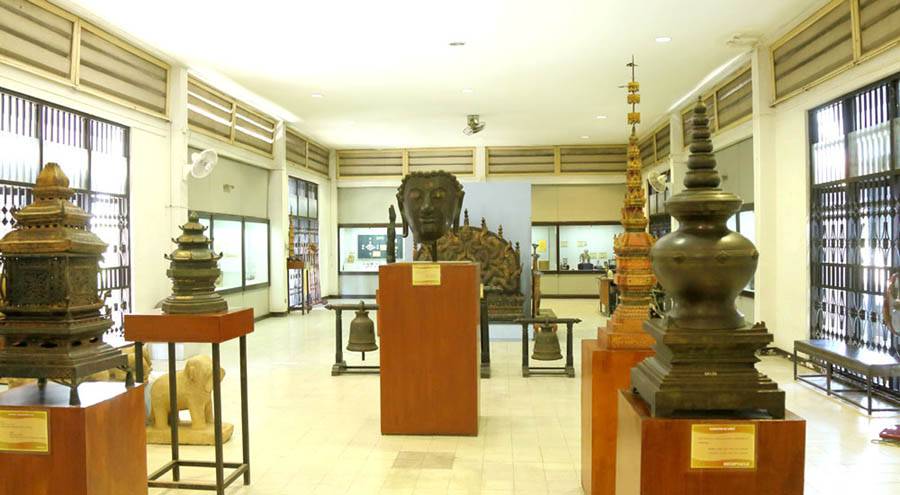
Haripunchai National Museum. Various exhibits can be seen such as Buddha
images in Haripunchai style, Lanna style and Lopburi style, Terra-cotta
Buddha images, Stucco in Dvaravati style, sandstone objects, pottery and
prehistoric remains.
Lamphun has a great museum called "
Haripunchai National Museum". It has the name of the ancient kingdom, Haripunchai, not current
city "
Lamphun". Cool ! The museum is located around the center of the town, very
close to the royal temple
Wat Prathat Haripunchai.
The museum has the main building and other building. In the main building,
you'll see various exhibits such as Buddha images in Haripunchai style,
Lanna style and Lopburi style, Terra-cotta Buddha images, Stucco in Dvaravati
style, sandstone objects, pottery and prehistoric remains.
(Dvaravati is said the first Mon kingdom flourished from the 6th to the
11th century)
Other building shows the history and civilization of
Lamphun in details and the very interesting things are old wooden toilets. They
have a lot of curious items. :D
If you come by
Lamphun, especially the major tourist spot,
Wat Phrathat Haripunchai, why don't you drop by this museum next to the temple across the street.
(One thing: Don't forget to check if it's open or not when you want to
visit. Monday and Tuesday are their holiday !)
Now, let's check their ancient civilization with me !
[Haripunchai National Museum] Let's go to the museum !
|
The museum called "Haripunchai National Museum is located around the center of the town, very close to the royal temple
Wat Prathat Hariphunchai. It has the name of the ancient kingdom, Haripunchai, not current city
"Lamphun". Isn't it cool ?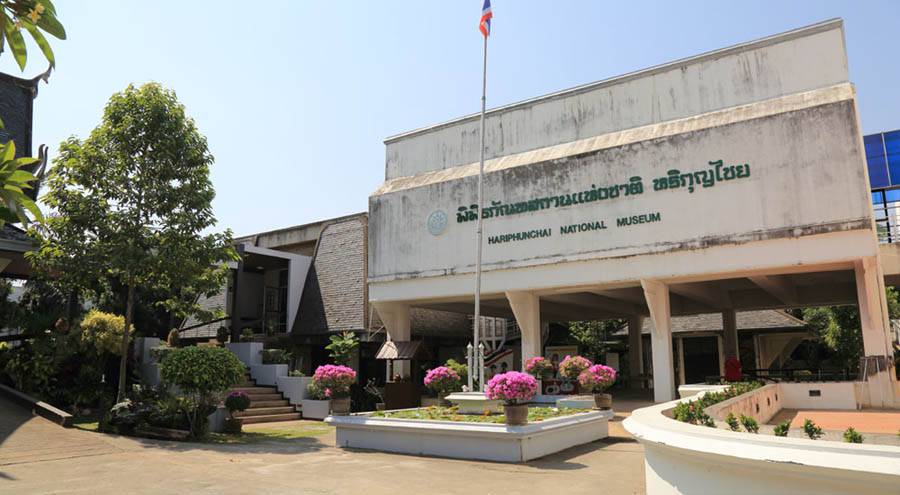
"Haripunchai National Museum, located around the center of the town, very close to the royal temple
Wat Prathat Haripunchai.
Check if it's open or not before you visit here. Monday and Tuesday are
their holiday ! |
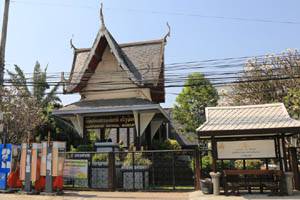
A tower-like building
|
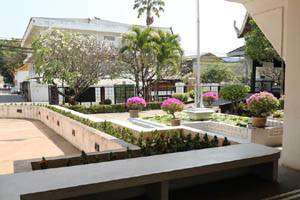
A cozy garden around the entrance.
|
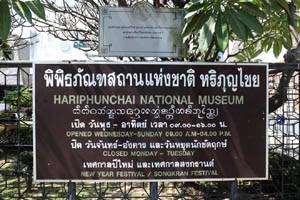
Check beforehand !
|
A tower-like building
to show this is Haripunchai museum facing a street in front. |
Garden。
A cozy garden around the entrance. |
Open/Close
Closed: Monday to Tuesday, New Year festival and Songkran festival. |
Back to top 
[Haripunchai National Museum] Various Exhibits
|
You'll see various exhibits in the museum such as Buddha images in Haripunchai
style, Lanna style and Lopburi style, Terra-Cotta Buddha images, Stucco
in Dvaravati style, sandstone objects, pottery and prehistoric remains.
(Dvaravati is said the first Mon kingdom flourished from the 6th to the
11th century)
I maybe missed the explanation of Haripunchai styled Buddha images but
I feel the images in Haripunchai style show similar to ordinary people
or they give visitors a sense of affinity.
About Buddha images in Lanna style, a detailed explanation is displayed
as follows;
- Buddha statues in Lanna style
- The early Lannna style (sometimes called "Chiang Saen") represents
Buddha images made there while the city was still a major centre before
the founding of Chiang Mai in 1296.
There is an unresolved problem of dating what some believe to be the earliest
show thai images of the Buddha: A series of sophisticated and distinctive
bronze castings show the clear influence of the Pala and Sena schools of
Northern India (8th - 12th century A.D)
- Typical features are a round face with lowered eyes: arched and clearly
separated eyebrows; sharp nose and small, fleshy lips; hair rendered in
Large curls on the head crowned by a lotus bud: prominent chin and a strong
body.
- After Chiang Mai became the center of Lanna and through to the 16th century, Buddha sculpture
made at the new capital are referred to as late chiang saen style or "Lanna-Chiang
Mai". This style reveals the influence of Sukhothai with a more slender face and body. The fold of the robe descending lower
to the waist. And while the early style has a low base, the late Chiang
Saen image has a high base often decorated with lotus petals.
|
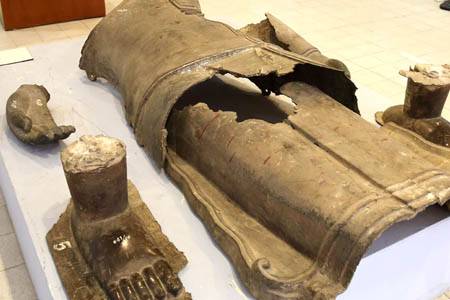
Disclosed the Three Worlds
The image of Lord Buddha disclosing the Three Worlds; the Upperworld, the
Mundane World, and the Underworld.
The body and both arms were moved from Wat Prathat Haripunchai and the
rest were found at Wat Don Kaew (Wiengyong school nowadays).
|
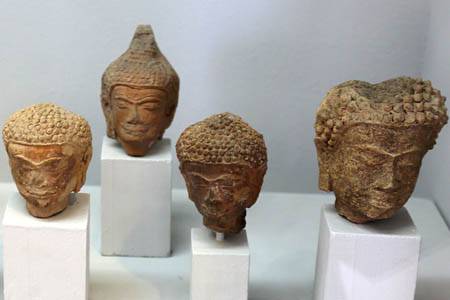
Terra - Cotta
Hariphunchai Style. Late 12th to 14th century A.D.
|
Disclosed the Three Worlds
The image of Lord Buddha disclosing the Three Worlds; the Upperworld, the
Mundane World, and the Underworld.
The body and both arms were moved from Wat Prathat Haripunchai and the
rest were found at Wat Don Kaew (Wiengyong school nowadays). |
Terra - Cotta
Hariphunchai Style. Late 12th to 14th century A.D. |
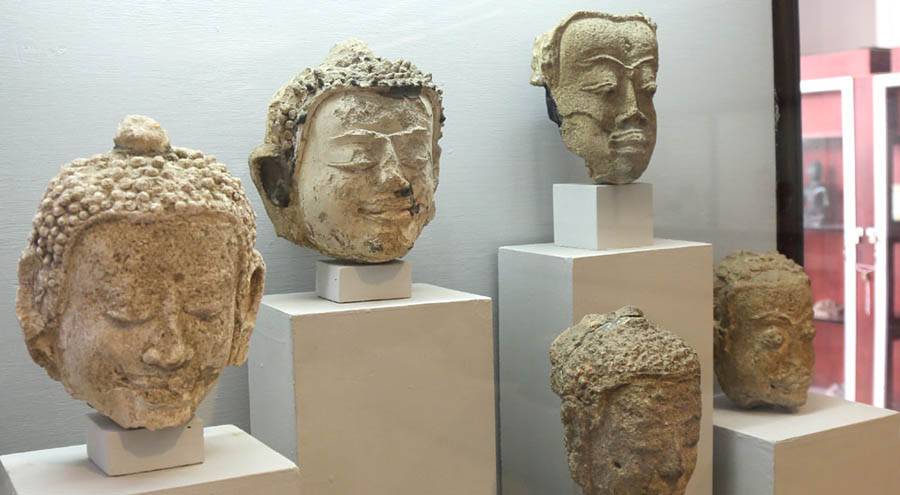
Buddha images 12th to 13th century A.D. in Haripunchai style.
Stucco is a material used as decorative coating for walls and ceilings
and as a sculptural and artistic material in architecture.
|
Stucco Hariphunchai Style
Buddha images 12th to 13th century A.D. in Haripunchai style.
Stucco is a material used as decorative coating for walls and ceilings
and as a sculptural and artistic material in architecture. Check Wiki about Stucco |
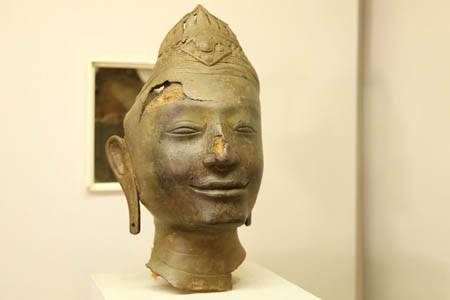
A calm look. The head is broken. There is a mirror behind and you can see
the inside.
|
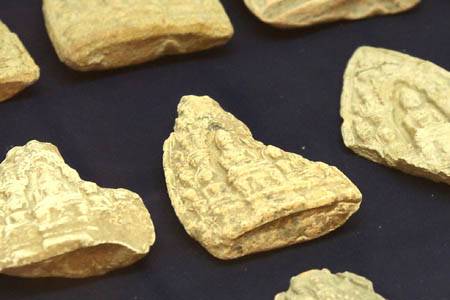
Hariphunchai style 10th to 13th century A.D.
|
Buddha image with a mirror behind
A calm look. The head is broken. There is a mirror behind and you can see
the inside. |
Terra Cotta - Small Buddha images
Hariphunchai style 10th to 13th century A.D. |
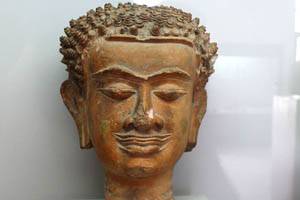
Terra Cotta - Buddha image
Hariphunchai style late 12th to 14th century A.D.
|
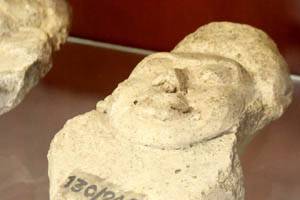
Stucco in Dvaravati style
Stucco is a material used as decorative coating for walls and ceilings
and as a sculptural and artistic material in architecture.
|
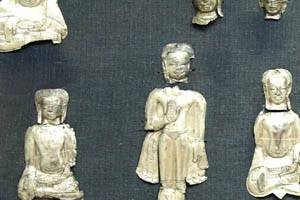
Silver Buddha images
Haripunchai style 12th to 14th century A.D.
|
Terra Cotta - Buddha image
Hariphunchai style late 12th to 14th century A.D. |
Stucco in Dvaravati style
Stucco is a material used as decorative coating for walls and ceilings
and as a sculptural and artistic material in architecture.
(Dvaravati is said the first Mon kingdom flourished from the 6th to the
11th century) |
Silver Buddha images
Haripunchai style 12th to 14th century A.D.
|
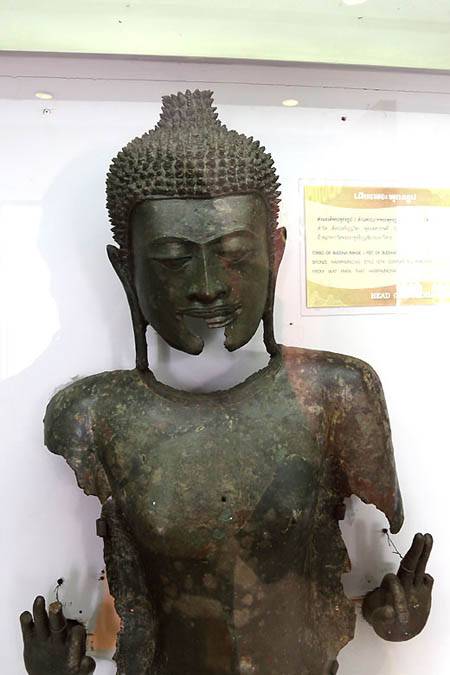
Bronze Buddha image
Haripunchai style 12 the century A.D.
The mudra (hand gestures) is 中品上生 (Chuubon Joushou, Upper, Middle Birth).
|
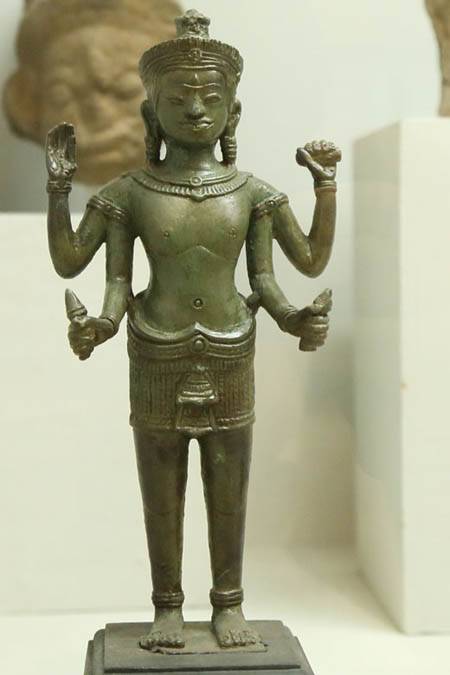
Buddha image in Lopburi style
Buddha image in Lopburi style 11th to 13th century A.D.
Apparently different from Lanna styled images such as the face.
|
Bronze Buddha image
Haripunchai style 12 the century A.D.
The mudra (hand gestures) is 中品上生 (Chuubon Joushou, Upper, Middle Birth).
|
Buddha image in Lopburi style
Buddha image in Lopburi style 11th to 13th century A.D.
Apparently different from Lanna styled images such as the face. |

The view of the main building in the back. Various exhibits are displayed.
|
In the main building
The view of the main building in the back. Various exhibits are displayed. |
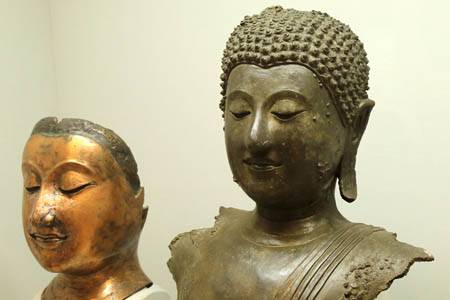
Bronze image Lanna style
Bronze Lanna style late 17th to 18th century A.D.
|
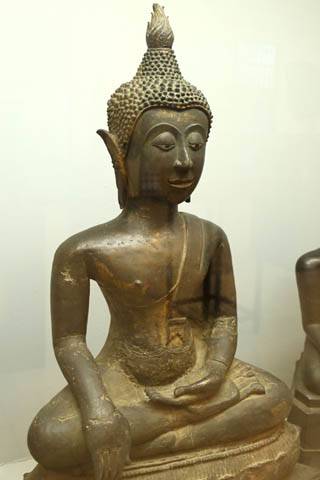
Bronze image in Lanna style
Bronze Lanna style late 18th to 19th century A.D. The image with opened
eyes, looking forward. Very distinguishing.
|
Bronze image Lanna style
Bronze Lanna style late 17th to 18th century A.D. |
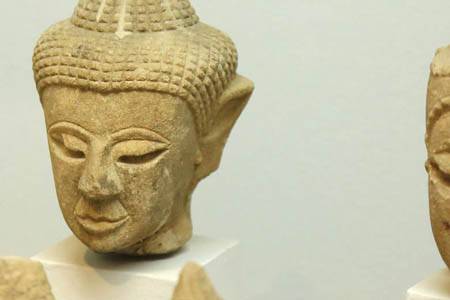
Lanna style, Payao school
Buddha image 15th to 16th century. Payao School.
|
Lanna style, Payao school
Buddha image 15th to 16th century. Payao School. |
Bronze image in Lanna style
Bronze Lanna style late 18th to 19th century A.D. The image with opened
eyes, looking forward. Very distinguishing. |
- The Payao School is explained as follows:
Although the so-called decline period of Lanna saw court patronage of the
arts ebbs away, it did see the emergence of local art movements and styles.
One such school was in Payao, which developed an independent school of
sandstone carving as well as a thriving ceramic industry, lying outside
invasion routes, Payao achieved long periods of peace, which made it a
good, centre of trade and manufacturing. Its fertile valley also helped
it obtain prosperity and autonomy, it was annexed to the Lanna kingdom
in 1338 A.D. unlike Lamphun, which had laterite; Payao was blessed with an abundance good quality
sandstone. The elephants was a popular figure for Payao sculptors revealing
Sri Lankan influence by way of Sukhothai.
|
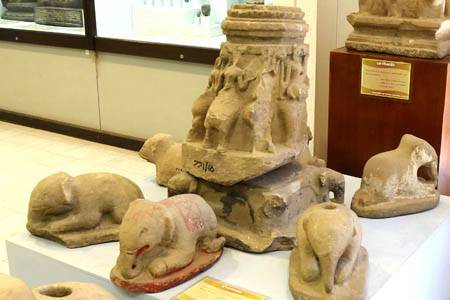
Sand Stone Object
Sand Stone Object, Payao School, Lanna style 16th to 17th century. A.D.
The elephants support the base and the Buddha images support the upper
pedestal ?
|
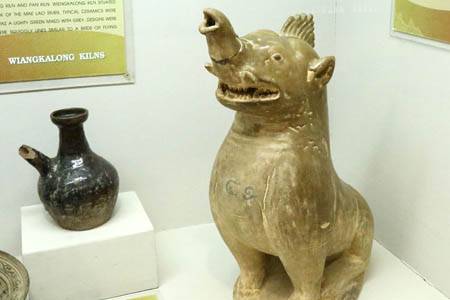
KOD-CHA-SI
An imaginary animal having a lion's body and elephant's trunk.
Ceramic Pan Kiln Chiangrai. Lanna style 17th to 19th century A.D.
|
Sand Stone Object
Sand Stone Object, Payao School, Lanna style 16th to 17th century. A.D.
The elephants support the base and the Buddha images support the upper
pedestal ? |
KOD-CHA-SI
An imaginary animal having a lion's body and elephant's trunk.
Ceramic Pan Kiln Chiangrai. Lanna style 17th to 19th century A.D. |
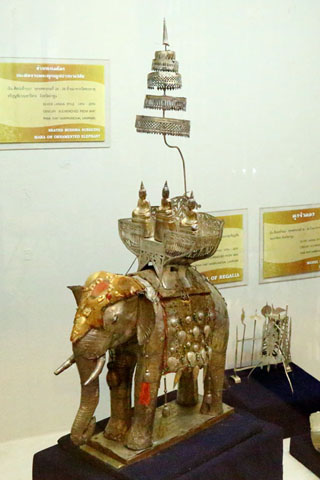
Silver object
Lanna style 19th to 20th century A.D。
|
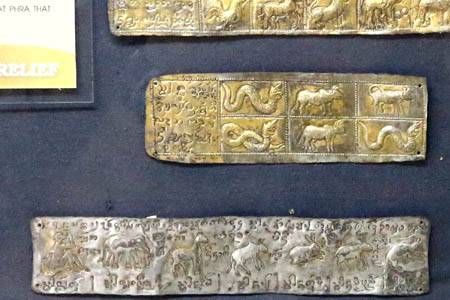
Brass And Silver works
Lanna style 19th to 20th century A.D.
|
Brass And Silver works
Lanna style 19th to 20th century A.D. |
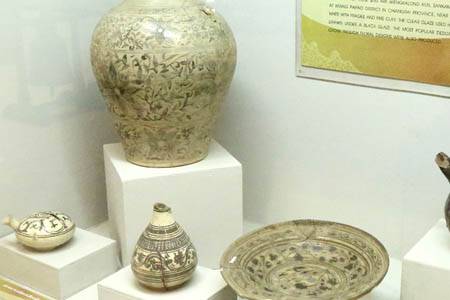
Lanna ceramics around the 15th century
|
Silver object
Lanna style 19th to 20th century A.D。 |
Lanna ceramics around the 15th century
Lanna ceramics have been found at many kiln sites, and the most important
of them is Wieng Kalong kiln, Sankamphaeng kiln and Pan kiln.
Typical ceramics were white with fragile and fine clay. The clear glaze
used here was a light green mixed with gray. |
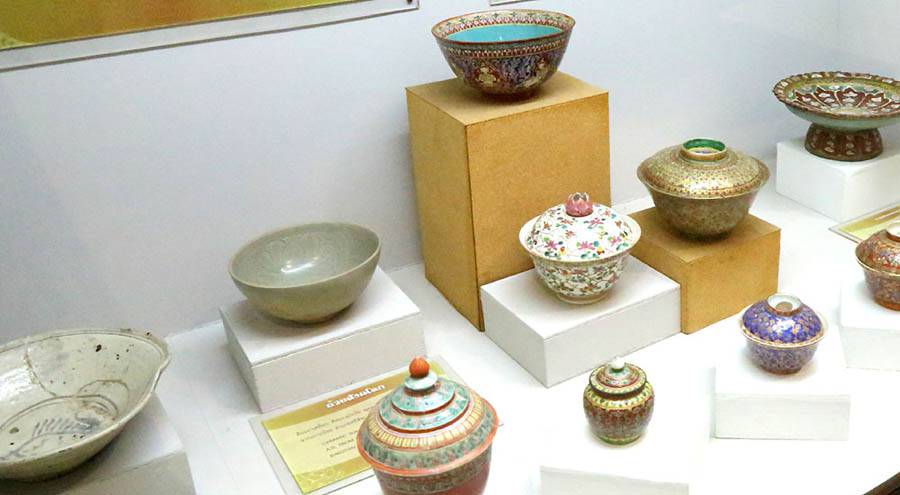
Sangkalok Ceramics (left) and Bencharong (right)
|
Sangkalok Ceramics (left)
"Sangkalok" is the ceramic ware produced during the Sukhothai and Ayudhaya period (14th to the late 16th centuries). The kilns ware situated in two
different places:
1) The Sukhothai kilns: They produced monochrome white-glazed and underglazed black ware.
2) The Srisachanalai kilns: Srisachanalai kilns produced high quality products such as celadon, underglazed black,
monochrome white-glazed, monochrome brown-glazed, two-colors glazed and
unglazed wares. |
Bencharong (right)
Bencharong dating from the 17th - 19th centuries or during the late Ayutthaya to the reign of RAMA IV. This term refers to porcelain painted with overglazed
enamel in five or more colors. Bencharong had been popular with the Chinese
since the Ming Dynasty, and especially in the reign of king Wanli. Thai
Bencharong was ordered from the kilns of Kingdezhen(Jingdezhen), Fujien
and Kwangtung provinces. The quality of bencharong was usually for use
in the royal household because of its superb handiwork, delicacy and beauty. |
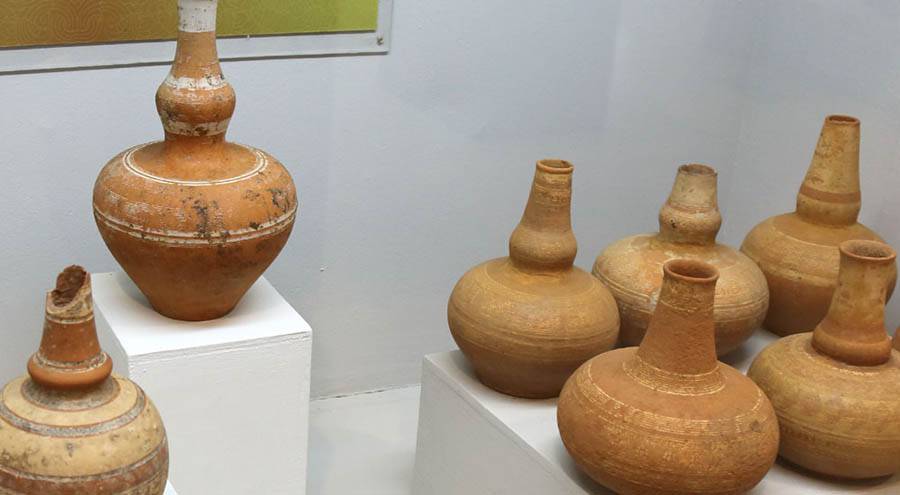
Hariphunchai Pottery
Some experts believe that they were made between the 9th to 14th centuries
because the oldest art objects show Indian influence from the Pala Dynasty.
They feature round bodies, high necks and red-painted decorations.
|
Hariphunchai Pottery
Some experts believe that they were made between the 9th to 14th centuries
because the oldest art objects show Indian influence from the Pala Dynasty.
They feature round bodies, high necks and red-painted decorations.
They have two styles:
1) A simple style decorated by drawing red lines around the neck and shoulder.
2) Decorated using the characteristics of the vessel itself. |
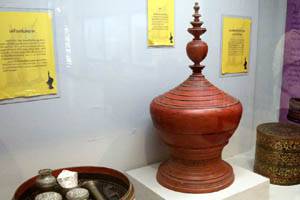
Lacquerware
The earliest Thai lacquerware dates back to Ayutthaya period
|
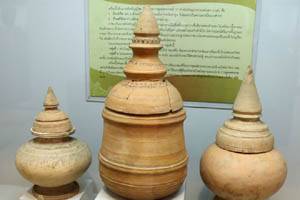
Terra-Cotta Pottery
Hariphunchai style, 12th to 13th century A.D.
|
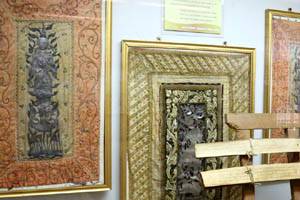
Silver Fabric
Fabric decorated with silver sheet Lanna style, 19th to 20 century A.D.
|
Lacquerware
The earliest Thai lacquerware dates back to Ayutthaya period. The technique of the lacquer work is still practiced in Thailand
today, especially in Chiang Mai. |
Terra-Cotta Pottery
Hariphunchai style, 12th to 13th century A.D. |
Silver Fabric
Fabric decorated with silver sheet Lanna style, 19th to 20 century A.D. |
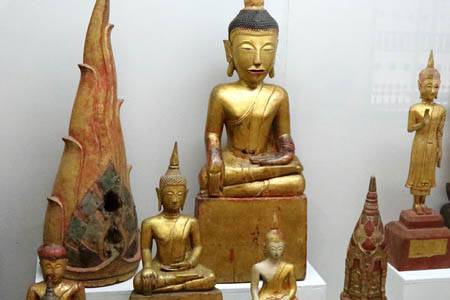
Buddha images in Gilt
Lanna style, Bermese (Burmese ?) school, 19th to 20th century A.D.
The balance of whole body and the expression are curious.
|
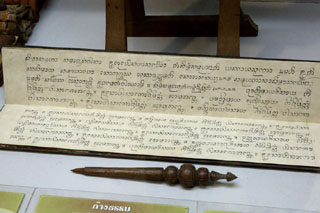
What is this characters ?
A lot of letters are written. Haripunchai alphabets ?
|
Buddha images in Gilt
Lanna style, Bermese (Burmese ?) school, 19th to 20th century A.D.
The balance of whole body and the expression are curious. |
What is this characters ?
A lot of letters are written. Haripunchai alphabets ? |
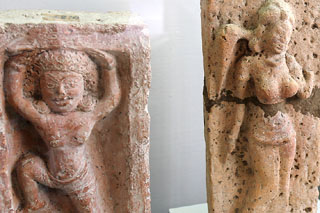
Terra-cotta Buddha images
Dvaravati style, 10th to 11th century.
(Dvaravati is said the first Mon kingdom flourished from the 6th to the
11th century)
|
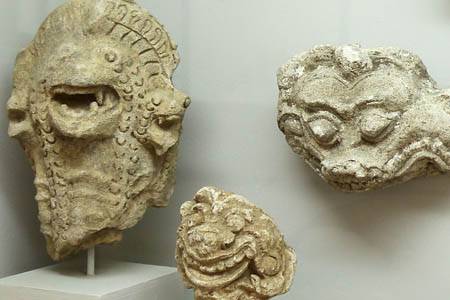
Sandstone objects
Haripunchai style, 12th century A.D.
Animals ?
|
Terra-cotta Buddha images
Dvaravati style, 10th to 11th century.
(Dvaravati is said the first Mon kingdom flourished from the 6th to the
11th century) |
Sandstone objects
Haripunchai style, 12th century A.D.
Animals ? |
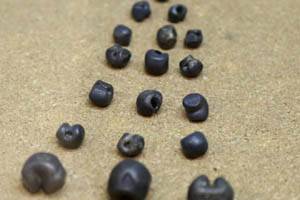
Phot Duang money (Bullet coins) used before the reign of King Rama IV.
|
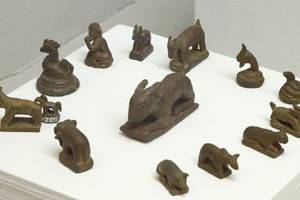
For weighting small things such as silver, gold and opium. Lanna style,
19th to 20th century A.D.
|
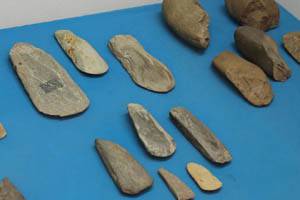
Prehistoric remains
Prehistoric remains about 500,000 to 100,000 years ago were found.
|
Old coins
Phot Duang money (Bullet coins) used before the reign of King Rama IV. |
Paeng : Opium weight in animal shape
For weighting small things such as silver, gold and opium. Lanna style,
19th to 20th century A.D. |
Prehistoric remains
Prehistoric remains about 500,000 to 100,000 years ago were found. |
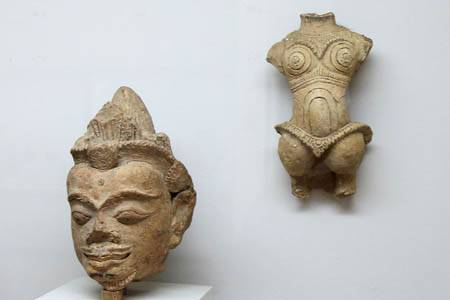
The shape of the body right is impressive.
|
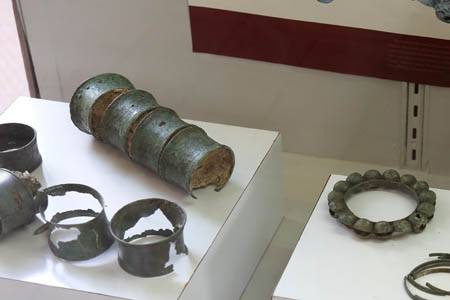
Bronze bangles (left) were found on children as often as or more often
than on adults.
Bronze bracelet (right) is adorned with small bells decorated with concentric
circles.
Both look they were made by the lost wax process.
|
| The shape of the body right is impressive. |
Bronze bangles and bracelets
Bronze bangles (left) were found on children as often as or more often
than on adults.
Bronze bracelet (right) is adorned with small bells decorated with concentric
circles.
Both look they were made by the lost wax process. |
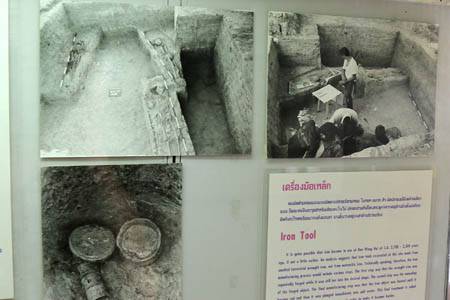
Excavation
They show pictures of excavation such as bones and tools.
Iron tools were used 2,700 to 2,500 years ago.
|
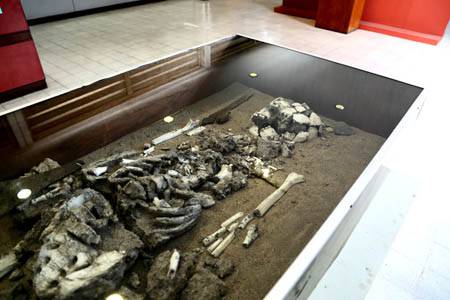
Human remains
Bones are displayed. Replica ?
|
Excavation
They show pictures of excavation such as bones and tools.
Iron tools were used 2,700 to 2,500 years ago. |
Human remains
Bones are displayed. Replica ? |
Back to top 
Don't forget to check another building !
|
After enjoying the mail building, let's go to another.
I almost forgot to visit there but the staff gestured for me to go there
when we were leaving the main building. Thanks ! |
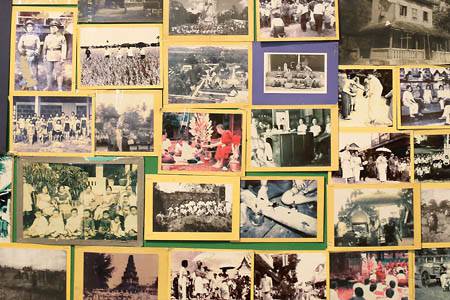
A lot of photos related to Lamphun
You'll see a lot of photos are displayed about Lamphun.
|
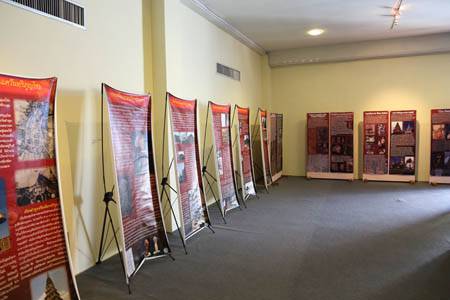
They show the history (from ancient, Haripunchai until present day), Buddhism,
the queen Cham Thewi and so on of Lamphun. |
A lot of photos related to Lamphun
You'll see a lot of photos are displayed about Lamphun. |
About Lamphun
They show the history (from ancient, Haripunchai until present day), Buddhism,
the queen Cham Thewi and so on of Lamphun. |
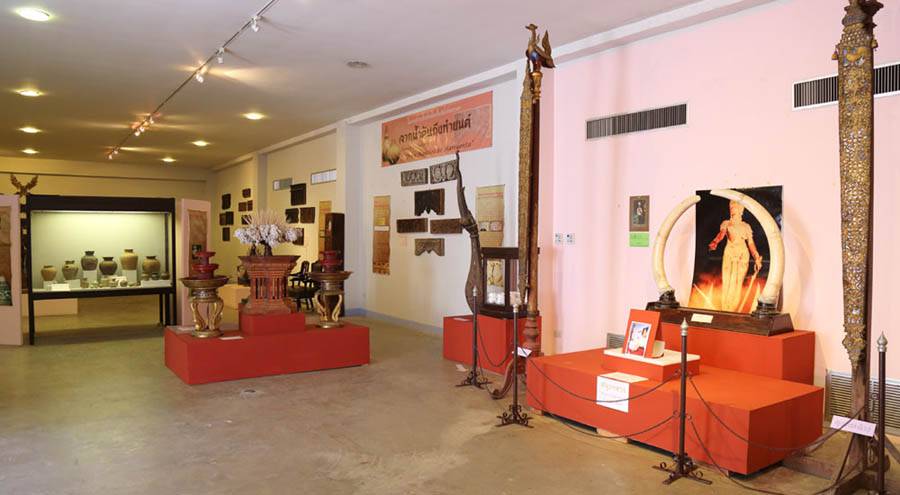
A view of another building on the left after entering.
|
| A view of another building on the left after entering. |
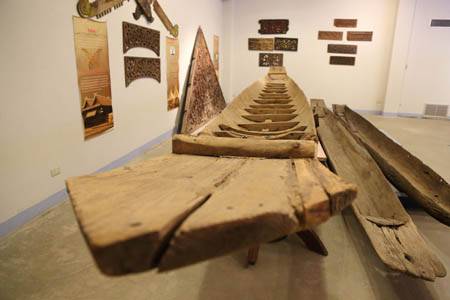
A boat a long time ago.
|
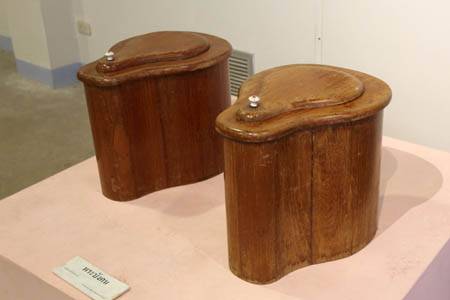
Toilets a long time ago. Almost never seen this kind of thing in a museum.
Curious. :D
|
| A boat a long time ago. |
Toilets a long time ago. Almost never seen this kind of thing in a museum.
Curious. :D |
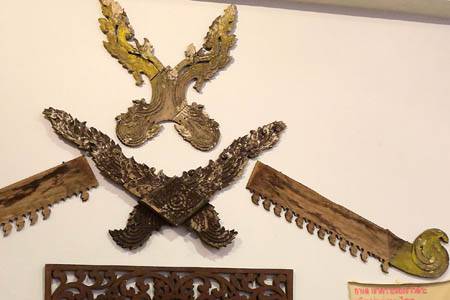
This is called Kalae, seen on gabled rooftops of traditional houses in Northern Thailand.
|
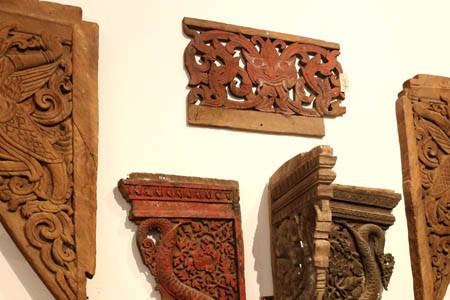
Supporting roof cave ornaments
Often in Thai temples, called Eave Bracket. In Northern Thai temples, they
are usually in the form of a Punished Naga and often called "Naga-Tan".
|
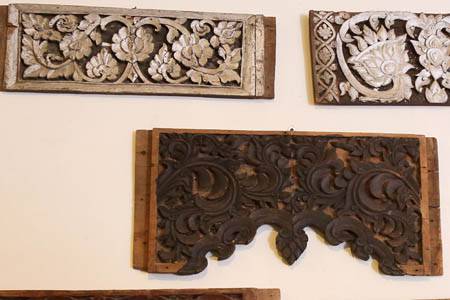
Carved Lanna Lintel
Lintel is a horizontal block above between two vertical supports. It's
called "Hamyon" in Lanna style and it's not only decoration but
protects a house.
|
Typical rooftop ornament
This is called Kalae, seen on gabled rooftops of traditional houses in Northern Thailand. |
Supporting roof cave ornaments
Often in Thai temples, called Eave Bracket. In Northern Thai temples, they
are usually in the form of a Punished Naga and often called "Naga-Tan". |
Carved Lanna Lintel
Lintel is a horizontal block above between two vertical supports. It's
called "Hamyon" in Lanna style and it's not only decoration but
protects a house. |
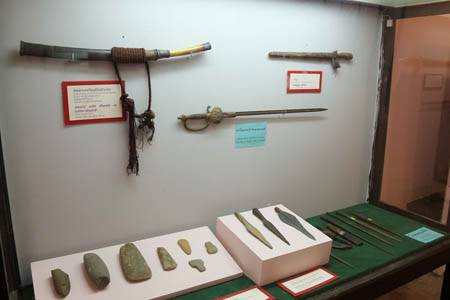
Swords, and stone tools.
|
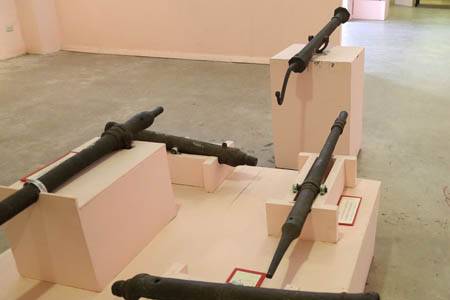
Handy canons ... ?
|
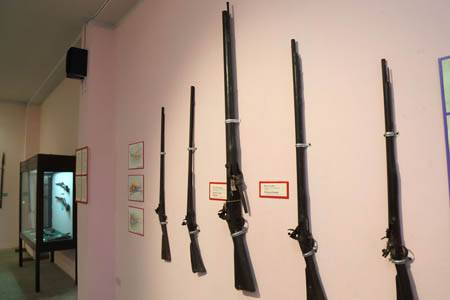
Rifle - The center is too much huge. Who can hand it ?
|
| Swords, and stone tools. |
Handy canons ... ? |
Rifle - The center is too much huge. Who can hand it ? |
Back to top 
Home > Photos (Thailand) > Lamphun > Gates, Wall, and the Town
 Lamphun has a great museum called "Haripunchai National Museum". It has the name of the ancient kingdom, Haripunchai, not current
city "Lamphun". Cool ! The museum is located around the center of the town, very
close to the royal temple Wat Prathat Haripunchai.
Lamphun has a great museum called "Haripunchai National Museum". It has the name of the ancient kingdom, Haripunchai, not current
city "Lamphun". Cool ! The museum is located around the center of the town, very
close to the royal temple Wat Prathat Haripunchai. Check if it's open or not before you visit here. Monday and Tuesday are
their holiday !
Check if it's open or not before you visit here. Monday and Tuesday are
their holiday !















































